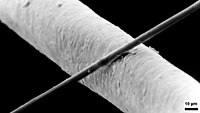
Photo from wikipedia
Abstract Epoxy is one of the most commonly used resins in the composite industry, but its inherent brittleness can limit its application. The insertion of thermoplastic polymers in the form of nanofibers… Click to show full abstract
Abstract Epoxy is one of the most commonly used resins in the composite industry, but its inherent brittleness can limit its application. The insertion of thermoplastic polymers in the form of nanofibers between composite layers is a recently introduced method for increasing the fracture toughness of these materials. In this study, electrospun polyvinylidene fluoride (PVDF) nanofibers were utilized to toughen carbon/epoxy laminates under mode-II loading. The results showed that the thickness of the nanomat is an important factor that determines the response of the modified laminates: double thickness leads to about double fracture toughness. The pictures obtained by optical microscope and SEM proved that the PVDF nanofibers melted and mixed with epoxy during the curing process and the toughening mechanism due to the plastic zone formation at the crack front. In the second part of the study, the ABAQUS software was used to find out cohesive parameters of the reference and nanomodified laminates and to consider the effect of the nanomat thickness on them.
Journal Title: Composite Structures
Year Published: 2019
Link to full text (if available)
Share on Social Media: Sign Up to like & get
recommendations!